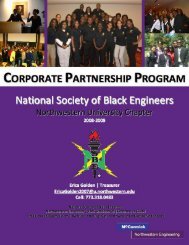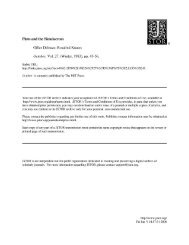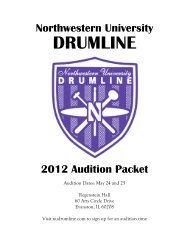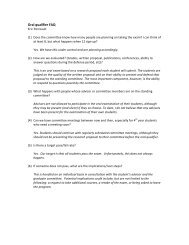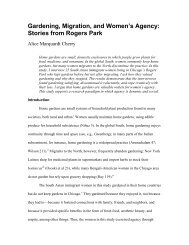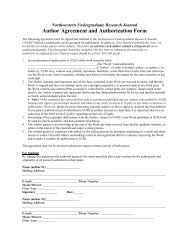research - Associated Student Government, Northwestern University
research - Associated Student Government, Northwestern University
research - Associated Student Government, Northwestern University
You also want an ePaper? Increase the reach of your titles
YUMPU automatically turns print PDFs into web optimized ePapers that Google loves.
RESEARCHism are more visible, while in suburban areas, politicstakes the form of community engagement.(4) Youth Background and Parental InvolvementAs Figure 5 and 6 both clearly show, exposure tovolunteering starting at a young age is a powerful indicatorof civic commitment later in life. Across allmotives, there is a significant increase in fervor due toobservations of parental and youth involvement whichthen shapes ones actions particularly at the universityage.B. Inferential StatisticsTable 1 shows that the public interest motive has thesmallest P-value, proving statistical significance. Multipleregressions allowed us to establish the adjusted r-squared value. This technique was utilized to minimizethe statistical effect that the four variables had on eachother, in essence to account for statistical shrinkage.Finally with an adjusted R-squared Value at 0.5225, wecan conclude that there exists a strong positive correlationbetween public interest and civic action returns.V. ConclusionWhile it is understood that the sample populationsurveyed here does not represent claims that can begeneralized to the public at large, we feel that the findingsof the <strong>Northwestern</strong> <strong>University</strong> students providesvaluable information in regards to exploring the overallmotivation and retention factors of individuals whotake part in voluntary service. For <strong>Northwestern</strong> <strong>University</strong>students, our findings showed that the type ofservice that one takes part in no way an indication ofones compassion level or likelihood of their civic actionreturn. However, those who took part in VES had higherrates than those who participated in VS generally inregards to their attraction to public policy, commitmentto public interest and self-sacrifice. The clearest signalof participation in VES and VS later in life is parentalperceptions and individual engagement at a young age.This assessment is a start to the future explorations ofenvironmental service, but by no means is a completeassessment of the overall goals of undergraduates engagedin VES or VS. For example, areas such as politicalaffiliation, majors of study and career goals would alsoprovide valuable information to this study. Finally, our<strong>research</strong> shows while there are fundamental similaritiesamong undergraduates who are civically engaged, therestill exist many distinctions between the motivating factorsof said service, and the willingness for undergraduatesto return to serve.AcknowledgementsWe would like to thank all of the undergraduateparticipants, who made this study possible. Additionally,without the help of Professor Yael Wolinsky andProfessor Jason Seawright’s guidance and generosity,this <strong>research</strong> endeavor would not have been possible.ReferencesAstin, Alexander W. & Sax, Linda J. How undergraduates are affected by serviceparticipation. Journal of College <strong>Student</strong> Development, Vol 39(3), May-Jun 1998, 251-263. Cohen, Jean L and Arato, Andrew. “Civil Society and Political Theory” Studies inContemporaryGerman Social Thought, Cambridge, Mass. 1992.Edwards, Bob and Mooney Linda A. “Experiential Learning in Sociology: Service Learningand Other Community-Based Learning Initiatives” Teaching Sociology Vol. 29, No. 2(Apr., 2001), pp. 181-194. Eisenhut, A. & Flannery, D. (2005). Fostering an Environmental Ethic through ServiceLearning. Californian Journal of Health Promotion, Volume 3, Issue 1, 92-102. Freire, P. (1970). Pedagogy of the oppressed. New York: Continuum.Furco, Andrew. “Service-Learning: A Balanced Approach to Experiential Education.”Expanding Boundaries: Service and Learning. Washington DC: Corporation for NationalService, 1996. 2-6.Holdsworth, Clare(2010) ‘Why Volunteer? Understanding Motivations For <strong>Student</strong>Volunteering’, British Journal of Educational Studies, 58: 4, 421 — 437Martinich, J. A., Solarz, S. L. and Lyons, J. R. (2006). Preparing <strong>Student</strong>s for ConservationCareers through Project-Based Learning. Conservation Biology, 20: 1579–1583.Measham, Thomas G. and Barnett, Guy B. “Environmental Volunteering: Motivations, Modesand Outcomes” Socio-Economics and the Environment in Discussion 2007.Miles, I, Sullivan, W.C., Kuo, F.E. “Ecological Restoration Volunteers: the benefits ofparticipation” Urban Ecosystems, 1998, 2, 27–41Moely, B. E., Mercer, S. H., Ilustre, V., Miron, D., & McFarland, M. (2002). Psychometricproperties and correlates of the Civic Attitudes and Skills Questionnaire (CASQ):A measure of students’ attitudes related to service-learning. Michigan Journal ofCommunity Service Learning, 8(2), 15-26.Moynihal, Donald P. and Pandy, Sanjay K. “The Role of Organizations in Fostering PublicService Motivation” Public Administration Review. 2007 Pgs 40 – 53Muir, M.J. and Schwartz, M. W. (2009). Academic Research Training for a NonacademicWorkplace: a Case Study of Graduate <strong>Student</strong> Alumni Who Work in Conservation.Conservation Biology, 23: 1357–1368Pastore, Alberto and Barbarossa, Camilla. 10th International Conference Marketing Trends,Paris, 20th-22nd January 2011.Perry, J. (1993, October). Public service motivation: Construct measurement and validation.Paper presented at the National Public Management Research Conference, Madison,WI.Perry, J. (1996). Measuring public service motivation: An assessment of construct reliabilityand validity, journal of Public Administration and Research, 6, 5-22.Perry, James L. “Bringing Society In: Toward a Theory of Public-Service Motivation J PublicAdm Res Theory (2000) 10(2): 471-488.Perry, J. (1997). Antecedents of public service motivation. Journal of Public AdministrationResearch and Theory, 7, 181-197.Ryan, Robert L., Kaplan, Rachel, Grese, Robert E. “Predicting Volunteer Commitment inEnvironmental Stewardship Programmes. Journal of Environmental Planning andManagement, 44(5), 629–648, 2001Shandas, V. & Messer, W. (2008). Fostering Green Communities Through Civic Engagement:Community-Based Environmental Stewardship in the Portland Area. Journal of theAmerican Planning Association, 74(4), 408-418. Whelan, J. (2002). Popular education for the environment: Restoring confidence ineducation as a strategy for social and environmental change. Keynote Presentation, ThirdInternational Education and Social Action Conference, <strong>University</strong> of Technology Sydney.December. VOLUME 7, 2011-2012NORTHWESTERN UNDERGRADUATE RESEARCH JOURNAL69



